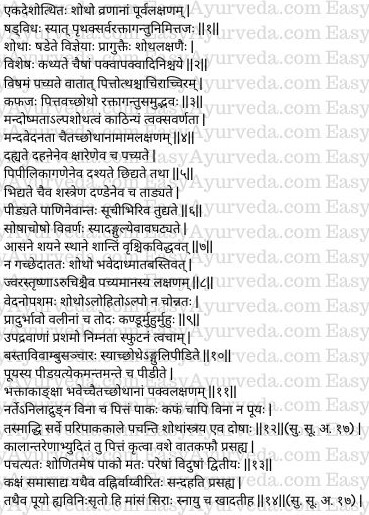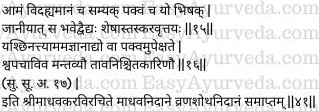Madhava Nidana Chapter 41 Vranashotha Nidanam
Introduction
This article explains Madava nidana 41st chapter “Vrana shotha Nidanam”. Causes, pathology and symptoms of Udavarta Anaha are explained in this chapter.

A swelling which is localized (and limited to a particular area of the body) becomes the premonitory symptom (stage) of an ulcer and is called as Vrana shopha. In short, Vrana shotha is a localized swelling which occurs prior to the formation of an ulcer. Vrana shopha is of six kinds – one each from each dosha (vataja, pittaja and kaphaja), one caused by combination of all three doshas, one from rakta (blood) and one from external causes (agantu). The symptoms of all these six kinds of vranasotha are similar to those explained in the context of the types of sotha previously.
Now, the special features of unripe and ripened stages of Vrana shopha will be described ahead. (1-2)
Read – Shotha: Causes, Types, Treatment, Medicines
Symptoms of Vrana shotha
Specific symptoms of the types of Vranashotha
Vātaja type of Vranashotha undergoes ripening inconsistently. Pittaja type of vranasotha will undergo quick suppuration. Kaphaja vranasotha will undergo suppuration very slowly. The raktaja and agantuja vranasothas will have symptoms similar to those of pittaja vranasotha. (3)
Ama Vranashotha Symptoms – In the unripe stage of Vranashotha the swelling is slightly warm. There is also mild swelling. The swelling is hard, has normal colour of the skin and mild pain.
Pacyamana Vranashotha Symptoms – In the ripening stage of Vranashotha there will be a severe burning sensation as if being burnt by fire or being corroded by strong alkali. The person will feel as if the region of swelling is being bitten by a swarm of ants, being cut or torn by sharp instruments, beaten by a baton, being pressed or squeezed by hands, pricked by (pierced by) needles, is being burnt and as if being burnt in the flanks, discoloration, pain as if being pressed by fingers.
The patient would not find comfort either by sitting, sleeping or standing and will experience continuous pain similar to that of a scorpion sting. The swelling is distended and expanded similar to a urinary bladder filled and distended by urine.
This condition is associated with fever, thirst and loss of taste. (4-8)
Read – Charaka Vrana Chikitsa – 25th Chapter – Wounds, Ulcers
Pakva Vrana shotha Symptoms – Reduction in the severity of pain, reduction in the size of swelling, reduction or absence of redness, absence of elevation, appearance of wrinkles on the swelling, repeated episodes of pricking pain and itching, and reduction of complications are seen in the ripened Vrana shopha. The swelling easily pits on pressure with the fingers, cracks appear on the skin, and the movements resembling the movement of water in the bladder or in a water bag are perceived in the swelling when it is pressed with the finger. When the swelling is pressed on one of its edges (side), the pressure of the pus is experienced on the other side of the swelling. The patient would develop a desire for food. (9-11)
Read – Charaka – Shotha Chikitsa 12th Chapter

A true physician should know the stages of Vranashotha
Only he who can recognize the unripe, ripening and ripened stages (of the inflammatory swellings) deserves to be called as a physician. All others are only imposters. (14)
He who cuts open the swelling in its unripe stage with ignorance or he who delays its opening though fully ripened-both are to be considered as very mean persons, because they are uncertain in their act. (15)
Thus ends the chapter on Vranashota Nidanam in Madhava Nidana text written by Acharya Madhavakara.









